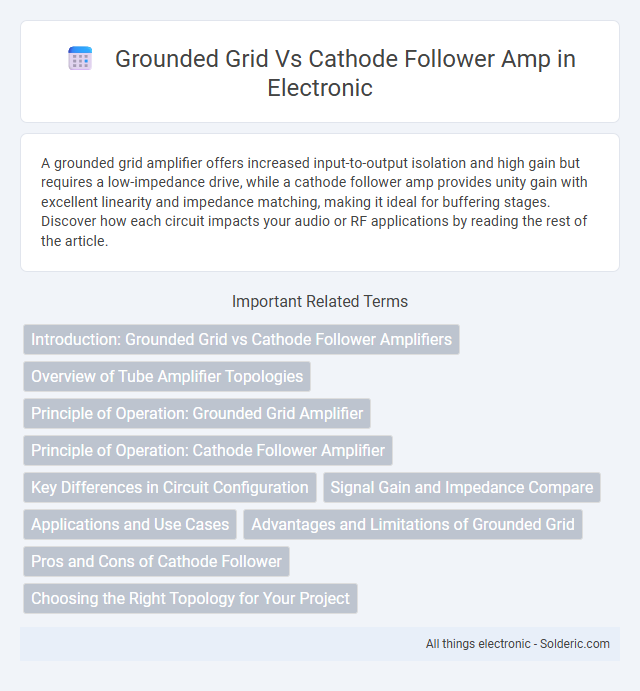A grounded grid amplifier offers increased input-to-output isolation and high gain but requires a low-impedance drive, while a cathode follower amp provides unity gain with excellent linearity and impedance matching, making it ideal for buffering stages. Discover how each circuit impacts your audio or RF applications by reading the rest of the article.
Comparison Table
| Feature | Grounded Grid Amplifier | Cathode Follower Amplifier |
|---|---|---|
| Configuration | Triode with grid at AC ground | Triode with cathode as output |
| Input Impedance | Low | High |
| Output Impedance | High | Low |
| Voltage Gain | High | Approximately unity (<= 1) |
| Current Gain | Moderate | High |
| Phase Shift | No phase inversion | No phase inversion |
| Typical Use | RF amplifiers, impedance matching | Buffer stages, impedance matching |
| Advantages | Stable operation at high frequencies, good gain | Low output impedance, excellent buffering |
| Disadvantages | Low input impedance limits signal sources | Limited voltage gain, not suitable for voltage amplification |
Introduction: Grounded Grid vs Cathode Follower Amplifiers
Grounded grid amplifiers offer high-frequency stability and low input capacitance, making them ideal for radio frequency (RF) applications, while cathode follower amplifiers provide unity voltage gain with low output impedance, suited for buffering and impedance matching. Your choice depends on the need for voltage gain versus the necessity of low output impedance and signal buffering in your circuit design. Both amplifier types play crucial roles in optimizing performance for specific electronic applications.
Overview of Tube Amplifier Topologies
Grounded grid and cathode follower are key tube amplifier topologies with distinct configurations and performance characteristics. Grounded grid amplifiers feature the grid at AC ground, providing low input impedance and high gain, often used in RF amplification and high-frequency applications. Cathode follower amplifiers offer low output impedance and unity gain, making them ideal for impedance matching and buffering in audio and signal processing circuits.
Principle of Operation: Grounded Grid Amplifier
The grounded grid amplifier operates by holding the grid at a fixed potential, allowing the input signal to be applied directly to the cathode while the output is taken from the anode. This configuration provides high gain and wide bandwidth, as the grid's low input impedance minimizes Miller capacitance effects, improving stability and frequency response. You benefit from robust performance in RF amplification where linearity and low noise are critical factors.
Principle of Operation: Cathode Follower Amplifier
The cathode follower amplifier operates by using a triode vacuum tube or transistor configuration where the output is taken from the cathode, providing a low output impedance and high input impedance. This design ensures voltage gain close to unity while delivering current gain, making it ideal for impedance matching and buffering applications. Your circuit benefits from minimal signal distortion and stable voltage levels when employing a cathode follower amplifier.
Key Differences in Circuit Configuration
Grounded grid amplifiers utilize a vacuum tube configuration where the grid is held at ground potential, offering high gain and stability with minimal input capacitance, making them ideal for high-frequency applications. Cathode follower amplifiers feature a design where the output is taken from the cathode, providing low output impedance and excellent signal buffering with unity voltage gain. Your choice between these two depends on the specific requirements for gain, impedance matching, and signal integrity in the intended circuit configuration.
Signal Gain and Impedance Compare
Grounded grid amplifiers provide moderate voltage gain with exceptionally low input impedance, ideal for high-frequency and RF applications, whereas cathode follower amplifiers offer a voltage gain slightly less than unity but feature very high input impedance and low output impedance. The grounded grid stage excels in delivering signal amplification with stable gain and minimal Miller effect, while cathode followers serve primarily as impedance buffers to drive low-impedance loads without significant signal voltage increase. Signal gain in grounded grid circuits typically ranges from 5 to 20 times voltage gain, contrasting with cathode followers that maintain nearly 1x voltage gain but optimize impedance matching for maximal power transfer.
Applications and Use Cases
Grounded grid amplifiers excel in high-frequency RF applications where stability and low input capacitance are critical, such as in radio transmitters and high-gain stages. Cathode follower amps provide low output impedance and signal buffering, making them ideal for driving heavy loads or impedance matching in audio equipment and preamplifier circuits. Your choice between these amplifiers depends on whether you prioritize high-frequency performance or efficient signal buffering in your circuit design.
Advantages and Limitations of Grounded Grid
Grounded grid amplifiers offer high stability and low input capacitance, making them ideal for RF applications where minimizing feedback and distortion is crucial. Their main limitation is the lower input impedance, which may necessitate additional buffering stages in your circuit design. Despite this, grounded grid amps excel in high-frequency performance and robust operation under varying load conditions.
Pros and Cons of Cathode Follower
Cathode follower amplifiers offer low output impedance and excellent linearity, making them ideal for driving heavy loads and preserving signal integrity. Their main drawbacks include limited voltage gain, which can require additional amplification stages, and increased power dissipation due to constant bias currents. Understanding these trade-offs helps you choose the right configuration for your audio or signal processing needs.
Choosing the Right Topology for Your Project
Choosing the right topology between a grounded grid and a cathode follower amp depends on your project's requirements for gain, stability, and input impedance. Grounded grid amplifiers offer high gain and low input impedance, ideal for RF applications where minimal signal loss is crucial. Cathode follower amps provide unity gain with high input impedance and low output impedance, making them perfect for buffering and impedance matching in audio or signal processing circuits.
Grounded grid vs Cathode follower amp Infographic

 solderic.com
solderic.com